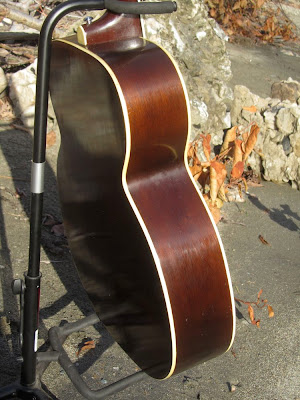c.1955 Kay K-22 Silvertone Jumbo Guitar
Update 2013: This guitar came back in trade and now it's available again! This time it comes with a brand new black, flat-top hard case in tow, too. Nice!
This big, beautiful, "iced-tea" sunburst jumbo Kay sure is a good bet for the heavy strummer. It's got a big, warm, balanced sound that can really crank the more you bang it hard. It's a fun guitar... and happens to stretch 17 1/8" on the lower bout!
This big, beautiful, "iced-tea" sunburst jumbo Kay sure is a good bet for the heavy strummer. It's got a big, warm, balanced sound that can really crank the more you bang it hard. It's a fun guitar... and happens to stretch 17 1/8" on the lower bout!
This one is a "K-22" model (so says its doubtful interior stamp) and has a solid (4 piece) spruce top with ladder bracing over laminate mahogany back and sides. The neck is a one-piece, baseball-bat profile, mahogany bit that has subtle curly figure here and there.
Kay jumbos, both the ladder-braced and (much more, extremely rare) x-braced types, sound much more "Martin" than "Gibson" in their tone. Bass is full but precise and rumbly while treble is clear and snappy. If you're expecting a J-200 tone, look elsewhere!
My work on this guitar included minor neck reinforcement (I opted to bolt this neck back to security rather than do a full reset), new rosewood bridge with ebony pins, fret level and dress, and installation of new tuners. Despite a (very tiny) relief of 1/64" down the neck, this plays "just right" at 3/32" on the bass and 1/16" on the treble at the 12th fret.
Original bone nut and "Silvertone" stencil. This meant that this particular guitar was resold by Sears.
The truly "coolest" part of this guitar is the modern-looking rosewood fretboard which uses a piece of rosewood that includes both heartwood and sapwood for a lovely contrasting-grain look. When I removed the original bridge I chose a replacement bridge that had sort of wide-open rosewood grain that would complement this sort of daring look.
Those frets are bigger brass types and dressed nicely.
And a curiosity of man Kays? They have narrow 1 5/8" nuts and long scales. Some stretch to 26" (very long) while this one is 25 3/4" (pretty darn long). This means that per a given string gauge, tension will be higher. Since the neck is unreinforced wood on this guitar, I strung it with 52w-11, though I imagine with that bigger round neck it could take 12s just fine, but mediums are house-wreckers, so they're out of the question!
Forgot to mention -- bound board, bound top, back, and soundhole.
Replacement rosewood bridge. I used some ebony pins. Note the string ramps for good back-angle. The new saddle is some sort of hard synthetic and it sounds just fine.
Update 2013: Above photo: when this guitar came back in trade I gave it a light setup (it plays perfectly: 1/16" treble and 3/32" bass at the 12th fret) and decided I wanted to allow more room for action adjustment in the future so I lightly shaved the front of the bridge to get more saddle exposed over the wood. I also quickly compensated the B string.
Update 2013: Above photo: when this guitar came back in trade I gave it a light setup (it plays perfectly: 1/16" treble and 3/32" bass at the 12th fret) and decided I wanted to allow more room for action adjustment in the future so I lightly shaved the front of the bridge to get more saddle exposed over the wood. I also quickly compensated the B string.
Isn't that mild sunburst so nice? No cracks on this guitar, by the way.
The finish has weather-crackle and checking all over but sure does manage to pop out the pretty mahogany back and sides.
I replaced the shot original Klusons with these repros which look and work just fine. I used the original mounting screws, though.
See the light curl/flame in the neck? I love that.
Here you can see my (strap-button-covered) bolt-reinforced heel join. I don't like doing this if I don't have to, but on old Kays from this era, the insurance of a bolted neck sure feels good. I had to do the same to my buddy's big old x-braced Kay jumbo because the neck pocket just was not cut right and was not worth the time to cut a new block, recut the heel, install it all, etc. to make it sturdy for the rigors of the road.
Original end pin.
Interior of the neck block showing the bolt-reinforced join.
Here's the original rosewood bridge and one of the Klusons I removed. The Klusons would have just been re-buttoned had they also not been totally rusted-out and cruddy. The original bridges on these are cool but terrible... they use the same idea of a c.1890s "Washburn" style bridge which loops the strings through the bridge internally and then up and over the saddle. This would be OK except that when someone needs to adjust the saddle lower, there's no room to do so since the holes limit how far you can recut a bridge and lower a saddle... bummer!
The bolted-on wings of the bridge were damaged in bolt removal because I had to get my pliers wrapped around the upholstery-style (decorative) bolt heads to actually remove them since even with the nuts and washers off inside the guitar, the bolts were still half-glued into the wings of the bridge so I couldn't get them out.
The short of it? These bridges are a pain in the butt!



















Comments